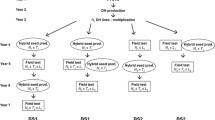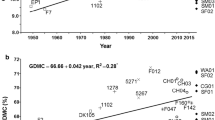Abstract
Hybrid wheat breeding programs need to use chemical hybridizing agents for seed production due to its simplicity. Alternative methods such as cytoplasmic systems or hand pollinations restrict genetic combinations or seed production which limits testing experimental hybrids in large-scale multi-environment trials (METs). Using F2 seed instead of F1 can allow programs to test hybrid cross combinations in METs and the data can be used to supplement selection decisions at early stages of breeding cycle. To test this hypothesis, two METs consisting of 40 entries were conducted in 2017 and 2018 in six locations across Texas and Nebraska. The entries included hybrids at the F2 stage and their respective parents, selected from a previous preliminary F1 evaluation experiment. In six out of 10 test environments, a F2 hybrid had statistically significant higher yield than highest yielding parent. The F2 mid-parent heterosis ranged from − 20.97 to 27.52% in 2017 and − 9.90 to 9.17% in 2018. The F2 high-parent heterosis ranged from − 21.07 to 17.85% in 2017 and − 16.57 to 6.68% in 2018. The heterosis estimates of these cross combinations at F1 stage were extracted from previous large scale METs conducted on nine environments across Nebraska and Texas in 2016–2017. A comparison of F2 heterosis from this study and F1 heterosis from the previous study revealed that F2 heterosis was highly indicative of superior F1 performance. The results provide strong evidence for utility of F2 yield data in selecting superior F1 hybrids. In addition, a practical framework for using F2 performance to aid selecting F1’s in a hybrid wheat-breeding pipeline is provided.





Similar content being viewed by others
Abbreviations
- METs:
-
Multi-environment trials
- GGE:
-
Genotype and genotype × environment interaction
- MPH:
-
Mid-parent heterosis
- HPH:
-
High parent heterosis
- TAMU:
-
Texas A&M University
- UNL:
-
University of Nebraska, Lincoln
- CHA:
-
Chemical hybridizng agent
References
Adhikari A, Ibrahim AM, Rudd JC, Baenziger PS, Sarazin JB (2020) Estimation of heterosis and combining abilities of US winter wheat germplasm for hybrid development in Texas. Crop Sci 60:788–803
Adugna A, Nanda GS, Singh K, Bains NS (2004) A comparison of cytoplasmic and chemically-induced male sterility systems for hybrid seed production in wheat (Triticum aestivum L.). Euphytica 135(3):297–304
Basnet BR, Crossa J, Dreisigacker S, Pérez-Rodríguez P, Manes Y, Singh RP, Rosyara UR, Camarillo-Castillo F, Murua M (2019) Hybrid wheat prediction using genomic, pedigree, and environmental covariables interaction models. Plant Genome 12(1):1–13
Basnet BR, Crossa J, Dreisigacker S, Pérez-Rodríguez P, Manes Y, Singh RP, Murua M (2019) Hybrid wheat prediction using genomic, pedigree, and environmental covariables interaction models. The Plant Genome 12(1):1–13
Butler DG, Cullis BR, Gilmour AR, Gogel BJ (2009) ASReml-R reference manual. The State of Queensland, Department of Primary Industries and Fisheries, Brisbane
Comstock RE, Robinson HF (1948) The components of genetic variance in populations of biparental progenies and their use in estimating the average degree of dominance. Biometrics 4(4):254–266
Comstock RE, Robinson HF (1952) Estimation of average dominance of genes. In: Gowen JW (ed) Heterosis. pp 494–516
Cox T, Murphy J (1990) The effect of parental divergence on F 2 heterosis in winter wheat crosses. Theor Appl Genet 79(2):241–250
Cregan P, Busch R (1977) Early generation bulk hybrid yield testing of adapted hard red spring wheat crosses 1. Crop Sci 17(6):887–891
Easterly AC, Stroup WW, Garst N, Belamkar V, Sarazin JB, Moittié T, Ibrahim AMH, Rudd JC, Souza E, Baenziger PS (2019) Determining the efficacy of a hybridizing agent in wheat (Triticum aestivum L.). Sci Reports 9(1):1–11
Easterly AC, Garst N, Belamkar V, Ibrahim AM, Rudd JC, Sarazin JB, Baenziger PS (2020) Evaluation of hybrid wheat (Triticum aestivum L.) yield in Nebraska. Crop Sci 60(3):1210–1222
Falconer DS, Mackay TFC (1996) Introduction to quantitative genetics, 4th edn. Longmans, Harlow, UK
Flachenecker C, Frisch M, Muminovic J, Falke K, Melchinger A (2006) Modified full-sib selection and best linear unbiased prediction of progeny performance in a European F2 maize population. Plant Breed 125(3):248–253
Friedrichs MR, Burton JW, Brownie C (2016) Heterosis and genetic variance in soybean recombinant inbred line populations. Crop Sci 56(4):2072–2079
Gerrish BJ, Ibrahim AM, Rudd JC, Neely C, Subramanian NK (2019) Identifying mega-environments for hard red winter wheat (Triticum aestivum L.) production in Texas. Euphytica 215(7):129
Ghaderi A, Adams M, Nassib A (1984) Relationship between genetic distance and heterosis for yield and morphological traits in dry edible bean and faba bean 1. Crop Sci 24(1):37–42
Gizlice Z, Carter TE, Burton JW (1993) Genetic diversity in North American soybean: II. Prediction of heterosis in F2 populations of southern founding stock using genetic similarity measures. Crop Sci 33(3):620–626
Gowda M, Longin CFH, Lein V, Reif JC (2012) Relevance of specific versus general combining ability in winter wheat. Crop Sci 52(6):2494–2500
Harrington J (1940) Yielding capacity of wheat crosses as indicated by bulk hybrid tests. Can J Res 18(11):578–584
Hockett E, Cook A, Khan M, Martin J, Jones B (1993) Hybrid performance and combining ability for yield and malt quality in a diallel cross of barley. Crop Sci 33(6):1239–1244
Immer F (1941) Relation between yielding ability and homozygosis in barley crosses. J Am Soc Agron 33(3):200–206
Isleib T, Wynne J (1983) Heterosis in testcrosses of 27 exotic peanut cultivars 1. Crop Sci 23(5):832–841
Joshi S, Sharma S, Singhania D, Sain R (2004) Combining ability in the F1 and F2 generations of diallel cross in hexaploid wheat (Triticum aestivum L. em. Thell). Hereditas 141(2):115–121
Knott D (1994) The use of bulk F2 and F3 yield tests to predict the performance of durum wheat crosses. Can J Plant Sci 74(2):241–245
Kotzamanidis ST, Roupakias D (2004) Plant density affects the reliability of using F1 and F2 yield to predict F3 yield in barley. Aust J Agric Res 55(9):961–965
Kotzamanidis S, Lithourgidis A, Mavromatis A, Chasioti D, Roupakias D (2008) Prediction criteria of promising F3 populations in durum wheat: a comparative study. Field Crops Res 107(3):257–264
Lefort-Buson M, Guillot-Lemoine B, Da Ttée Y (1986) Heterosis and genetic distance in rapeseed (Brassica napus L.). Use of different indicators of genetic divergence in a 7 × 7 diallel. Agronomie, EDP Sci 6(9):839–844
Lewers K, St Martin S, Hedges B, Palmer R (1998) Testcross evaluation of soybean germplasm. Crop Sci 38(5):1143–1149
Longin CFH, Gowda M, Mühleisen J, Ebmeyer E, Kazman E, Schachschneider R, Schacht J, Kirchhoff M, Zhao Y, Reif JC (2013) Hybrid wheat: quantitative genetic parameters and consequences for the design of breeding programs. Theor Appl Genet 126(11):2791–2801
Meredith WR (1990) Yield and fiber-quality potential for second-generation cotton hybrids. Crop Sci 30(5):1045–1048
Meredith W Jr, Brown JS (1998) Heterosis and combining ability of cottons originating from different regions of the United States. J Cotton Sci 2:77–84
Mette MF, Gils M, Longin CFH, Reif JC (2015) Hybrid breeding in wheat. In: Ogihara Y, Takumi S, Handa H (eds) Advances in wheat genetics: from genome to field. Springer, Tokyo, pp 225–232
Möhring J, Piepho HP (2009) Comparison of weighting in two-stage analysis of plant breeding trials. Crop Sci 49(6):1977–1988
Oettler G, Becker H, Hoppe G (2001) Heterosis for yield and other agronomic traits of winter triticale F1 and F2 hybrids. Plant Breed 120(4):351–353
Shehata A, Comstock V (1971) Heterosis and combining ability estimates in F2 flax populations as influenced by plant density 1. Crop Sci 11(4):534–536
Tang B, Jenkins JN, McCarty J, Watson C (1993) F2 hybrids of host plant germplasm and cotton cultivars: I. Heterosis and combining ability for lint yield and yield components. Crop Sci 33(4):700–705
Technow F (2019) Use of F2 bulks in training sets for genomic prediction of combining ability and hybrid performance. G3: Genes Genomes Genet 9(5):1557–1569
Troyer A (1986) Selection for early flowering in corn: 18 adapted F2 populations. Crop Sci 26(2):283–285
Winzeler H, Schmid J, Winzeler M (1993) Analysis of the yield potential and yield components of F 1 and F 2 hybrids of crosses between wheat (Triticum aestivum L.) and spelt (Triticum spelta L.). Euphytica 74(3):211–218
Wu Y, Yin J, Guo W, Zhu X, Zhang T (2004) Heterosis performance of yield and fibre quality in F1 and F2 hybrids in upland cotton. Plant Breed 123(3):285–289
Yan W, Tinker NA (2006) Biplot analysis of multi-environment trial data: principles and applications. Can J Plant Sci 86(3):623–645
Zadoks JC, Chang TT, Konzak CF (1974) A decimal code for the growth stages of cereals. Weed Res 14(6):415–421
Zhao Y, Li Z, Liu G, Jiang Y, Maurer HP, Würschum T, Mock H-P, Matros A, Ebmeyer E, Schachschneider R (2015) Genome-based establishment of a high-yielding heterotic pattern for hybrid wheat breeding. Proc Natl Acad Sci 112(51):15624–15629
Acknowledgements
We acknowledge the help of Geraldine Opena, Bryan Simoneaux, Russel L. Sutton, Jason Baker, Shannon Baker and Ravindra Devkota for help during planting, harvesting and data collection. We also would like to thank the funding from USDA NIFA-IWYP Grant No. 25-6222-0810-002, Monsanto Beachell Borlaug International Scholars Program, Texas Wheat Producers Board, Nebraska Wheat Board, and Texas A&M AgriLife Research.
Author information
Authors and Affiliations
Corresponding author
Ethics declarations
Conflict of interests
The authors declare that there is no competing interests between them or funding agencies.
Additional information
Publisher's Note
Springer Nature remains neutral with regard to jurisdictional claims in published maps and institutional affiliations.
Electronic supplementary material
Below is the link to the electronic supplementary material.
Rights and permissions
About this article
Cite this article
Adhikari, A., Ibrahim, A.M.H., Rudd, J.C. et al. Supplementing selection decisions in a hybrid wheat breeding program by using F2 yield as a proxy of F1 performance. Euphytica 216, 130 (2020). https://doi.org/10.1007/s10681-020-02664-0
Received:
Accepted:
Published:
DOI: https://doi.org/10.1007/s10681-020-02664-0




